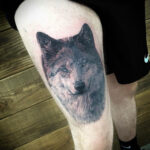Tattoos are a fantastic form of self-expression, but it’s important to remember that getting one is essentially creating a wound on your skin. Understanding the Stages Of Tattoo Healing is crucial for ensuring your new ink heals properly, looks vibrant, and avoids complications. The tattoo healing process is typically broken down into several distinct phases.
Stage 1: Oozing and Redness (Days 1-7)
Immediately after getting your tattoo, your artist will bandage the area. This bandage is usually removed within a few hours or up to a day, depending on your artist’s instructions. Once you remove it, don’t be alarmed if you see fluid and redness. It’s perfectly normal for a fresh tattoo to ooze plasma, blood, and excess ink – this is often called “weeping”. The skin around the tattoo will also be red and feel sensitive, similar to a sunburn. This initial stage is part of your body’s natural inflammatory response to the tattooing process. Expect this stage to last for about a week. If the redness and excessive oozing persist or worsen after a week, it’s important to consult with a doctor to rule out any potential infections.
Stage 2: Itching and Irritation (Week 1-2)
As your tattoo starts to heal, itching is a very common symptom. Think of it like any other wound healing – as new skin cells regenerate, it triggers an itch response. During the first and second weeks, your new tattoo will likely become increasingly itchy and may start to flake. It’s vital to resist the urge to scratch, no matter how tempting! Scratching can damage the healing skin and even pull out ink, leading to patchiness and potential scarring. To relieve the itch, try applying a gentle, fragrance-free lotion specifically designed for tattoo aftercare. You can also use a cold compress or ice pack over clothing to numb the area and alleviate the itching sensation. If the itching is unbearable, consider asking a pharmacist or doctor about over-the-counter antihistamines, which can help reduce the histamine response causing the itch.
Stage 3: Peeling and Dryness (Week 2-4)
Around the second, third, and fourth weeks, your tattoo will enter the peeling stage. This might look alarming, but it’s a positive sign that your tattoo is healing well. The peeling skin is simply the outer layer of dead skin cells sloughing off as the new skin underneath regenerates. Don’t pick or peel at the skin, as this can also affect the tattoo’s appearance. Let the peeling occur naturally. During this phase, your tattoo might also appear dry and even slightly dull as the new layer of skin is still maturing. Continue to moisturize regularly with a recommended tattoo lotion to keep the skin hydrated and support the healing process.
Stage 4: Settling and Long-Term Aftercare (Month 1+)
After the first month, the majority of the visible healing process is complete. Your tattoo should look much more vibrant and the skin texture will start to normalize. However, healing is still happening beneath the surface for several months. While the intense aftercare of the first few weeks might lessen, it’s essential to maintain good skincare practices long-term to keep your tattoo looking its best. This includes daily moisturizing to keep the skin hydrated and, crucially, protecting your tattoo from sun exposure. UV rays can fade tattoo ink over time, so diligent sunscreen application is vital for preserving the vibrancy and longevity of your tattoo. Proper long-term aftercare ensures your tattoo remains a beautiful piece of art for years to come.
